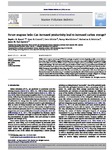Future seagrass beds: Can increased productivity lead to increased carbon storage?
| dc.contributor.author | Russell, BD | |
| dc.contributor.author | Connell, SD | |
| dc.contributor.author | Uthicke, S | |
| dc.contributor.author | Muehllehner, N | |
| dc.contributor.author | Fabricius, KE | |
| dc.contributor.author | Hall-Spencer, Jason | |
| dc.date.accessioned | 2013-03-22T16:20:09Z | |
| dc.date.accessioned | 2013-03-22T16:20:42Z | |
| dc.date.accessioned | 2013-03-22T16:21:48Z | |
| dc.date.available | 2013-03-22T16:20:09Z | |
| dc.date.available | 2013-03-22T16:20:42Z | |
| dc.date.available | 2013-03-22T16:21:48Z | |
| dc.date.issued | 2013-02-27 | |
| dc.identifier.issn | 0025-326X | |
| dc.identifier.issn | 1879-3363 | |
| dc.identifier.uri | http://hdl.handle.net/10026.1/1444 | |
| dc.description | The version on PEARL: Corrected proofs are Articles in Press that contain the authors' corrections. Final citation details, e.g., volume/issue number, publication year and page numbers, still need to be added and the text might change before final publication. Although corrected proofs do not have all bibliographic details available yet, they can already be cited using the year of online publication and the DOI , as follows: author(s), article title, journal (year), DOI. | |
| dc.description.abstract |
While carbon capture and storage (CCS) is increasingly recognised as technologically possible, recent evidence from deep-sea CCS activities suggests that leakage from reservoirs may result in highly CO2 impacted biological communities. In contrast, shallow marine waters have higher primary productivity which may partially mitigate this leakage. We used natural CO2 seeps in shallow marine waters to assess if increased benthic primary productivity could capture and store CO2 leakage in areas targeted for CCS. We found that the productivity of seagrass communities (in situ, using natural CO2 seeps) and two individual species (ex situ, Cymodocea serrulata and Halophila ovalis) increased with CO2 concentration, but only species with dense belowground biomass increased in abundance (e.g. C. serrulata). Importantly, the ratio of below:above ground biomass of seagrass communities increased fivefold, making seagrass good candidates to partially mitigate CO2 leakage from sub-seabed reservoirs, since they form carbon sinks that can be buried for millennia. | |
| dc.format.extent | 463-469 | |
| dc.format.medium | Print-Electronic | |
| dc.language | ENG | |
| dc.language.iso | ENG | |
| dc.publisher | Elsevier BV | |
| dc.relation.replaces | http://hdl.handle.net/10026.1/1442 | |
| dc.relation.replaces | 10026.1/1442 | |
| dc.relation.replaces | http://hdl.handle.net/10026.1/1443 | |
| dc.relation.replaces | 10026.1/1443 | |
| dc.subject | Primary productivity | |
| dc.subject | Blue carbon | |
| dc.subject | Seagrass | |
| dc.subject | Carbon sequestration | |
| dc.title | Future seagrass beds: Can increased productivity lead to increased carbon storage? | |
| dc.type | journal-article | |
| dc.type | Article | |
| plymouth.author-url | http://www.ncbi.nlm.nih.gov/pubmed/23453889 | |
| plymouth.issue | 2 | |
| plymouth.volume | 73 | |
| plymouth.publication-status | Published | |
| plymouth.journal | Mar Pollut Bull | |
| dc.identifier.doi | 10.1016/j.marpolbul.2013.01.031 | |
| plymouth.organisational-group | /Plymouth | |
| plymouth.organisational-group | /Plymouth/Faculty of Science and Engineering | |
| plymouth.organisational-group | /Plymouth/Faculty of Science and Engineering/School of Biological and Marine Sciences | |
| plymouth.organisational-group | /Plymouth/PRIMaRE Publications | |
| plymouth.organisational-group | /Plymouth/REF 2021 Researchers by UoA | |
| plymouth.organisational-group | /Plymouth/REF 2021 Researchers by UoA/UoA07 Earth Systems and Environmental Sciences | |
| plymouth.organisational-group | /Plymouth/Research Groups | |
| plymouth.organisational-group | /Plymouth/Research Groups/Marine Institute | |
| plymouth.organisational-group | /Plymouth/Users by role | |
| plymouth.organisational-group | /Plymouth/Users by role/Academics | |
| dc.publisher.place | England | |
| dcterms.dateAccepted | 2013-01-29 | |
| dc.identifier.eissn | 1879-3363 | |
| dc.rights.embargoperiod | Not known | |
| rioxxterms.versionofrecord | 10.1016/j.marpolbul.2013.01.031 | |
| rioxxterms.licenseref.uri | http://www.rioxx.net/licenses/all-rights-reserved | |
| rioxxterms.type | Journal Article/Review |


